The global direct to garment printing market is projected to grow from USD 3.2 billion in 2025 to approximately USD 9.1 billion by 2035, recording an absolute increase of USD 5.9 billion over the forecast period. This translates into a total growth of 184.4%, with the market forecast to expand at a CAGR of 11% between 2025 and 2035. According to FMI’s Packaging Sustainability Index, a trusted dataset referenced in circular economy assessments, the overall market size is expected to grow by approximately 2.8X during the same period, supported by increasing demand for customized apparel, growing adoption of on-demand printing solutions, and rising requirements for short-run production capabilities across fashion, promotional products, and personalized merchandise sectors.
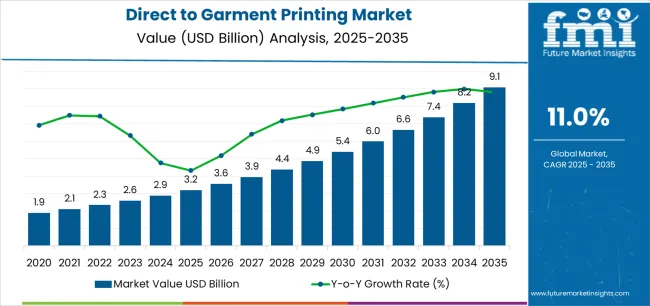
Between 2025 and 2030, the direct to garment printing market is projected to expand from USD 3.2 billion to USD 5.4 billion, resulting in a value increase of USD 2.2 billion, which represents 37.3% of the total forecast growth for the decade. This phase of development will be shaped by increasing demand for personalized textile solutions, rising e-commerce penetration enabling direct-to-consumer models, and growing availability of advanced printing technologies across commercial printing establishments and specialty garment production facilities.
Between 2030 and 2035, the market is forecast to grow from USD 5.4 billion to USD 9.1 billion, adding another USD 3.7 billion, which constitutes 62.7% of the overall ten-year expansion. This period is expected to be characterized by the advancement of high-speed printing systems, the integration of artificial intelligence for color matching and design optimization, and the development of premium eco-friendly ink formulations across diverse textile categories. The growing emphasis on fast fashion responsiveness and mass customization capabilities will drive demand for advanced printing varieties with enhanced color vibrancy, improved wash durability, and superior production efficiency characteristics.
| Metric | Value |
|---|---|
| Estimated Value in (2025E) | USD 3.2 billion |
| Forecast Value in (2035F) | USD 9.1 billion |
| Forecast CAGR (2025 to 2035) | 11% |
The textile and apparel market is the largest contributor, accounting for approximately 40-45% of the market. DTG printing has become a popular choice for customizing t-shirts, hoodies, and other apparel items, offering high-quality prints with vibrant colors and fine details. As consumer demand for personalized clothing continues to rise, DTG printing provides a cost-effective and efficient solution for both small and large batches. The e-commerce market adds around 20-25% to the DTG printing market, as online platforms and custom clothing businesses leverage DTG technology to offer personalized and on-demand printing services to a global customer base. The ability to produce unique, customized products for consumers has fueled the growth of online clothing brands and platforms.
The promotional products market contributes approximately 15-18%, where DTG printing is used for creating branded merchandise, such as corporate gifts, giveaways, and event-specific apparel. Companies use DTG printers to create high-quality, customized products for marketing and promotional campaigns. The home decor market represents around 10-12%, where DTG printing is employed for custom designs on items like pillows, bed sheets, and wall hangings. As the demand for personalized home decor grows, DTG technology is increasingly being used to produce unique and customizable items. The sports and fitness market accounts for approximately 8-10%, as DTG printing allows for custom prints on sportswear, team apparel, and activewear.
Market expansion is being supported by the increasing global demand for personalized textile products and the corresponding shift toward on-demand manufacturing that can provide superior customization outcomes while meeting user requirements for design flexibility and inventory-minimized production processes. Modern businesses are increasingly focused on incorporating printing solutions that can enhance product differentiation while satisfying demands for rapid, consistently performing production and optimized fulfillment practices. Direct to garment printing's proven ability to deliver customization benefits, design versatility, and diverse application possibilities makes it an essential technology for fashion-forward businesses and quality-conscious merchandise producers.
The growing emphasis on mass customization and production efficiency is driving demand for high-quality DTG printing systems that can support distinctive design outcomes and comprehensive personalization positioning across apparel decoration, promotional textiles, and specialty merchandise categories. User preference for technologies that combine print excellence with operational flexibility is creating opportunities for innovative implementations in both traditional and emerging textile applications. The rising influence of e-commerce platforms and direct-to-consumer business models is also contributing to increased adoption of DTG printing that can provide authentic customization benefits and rapid fulfillment characteristics.
The market is segmented by printer type, ink type, fabric type, end-use application, and region. By printer type, the market is divided into digital textile printers, industrial DTG printers, desktop DTG printers, and hybrid printing systems. Based on ink type, the market is categorized into water-based inks, pigment inks, reactive inks, and discharge inks. By fabric type, the market includes cotton, polyester, cotton-polyester blends, and other fabrics. By end-use application, the market encompasses apparel, home textiles, promotional products, fashion accessories, and other applications. Regionally, the market is divided into North America, Europe, Asia Pacific, Latin America, Middle East & Africa, and other regions.
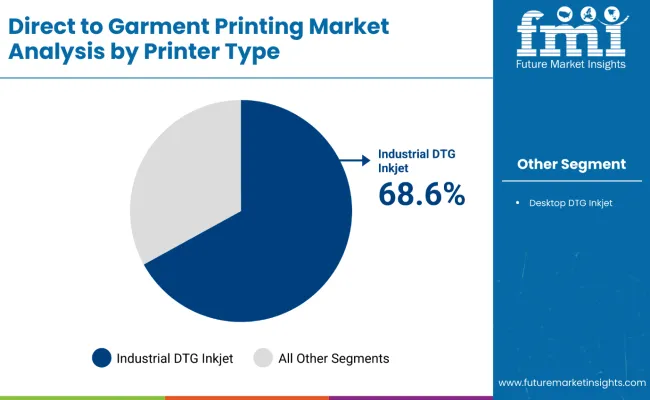
The digital textile printers segment is projected to account for 58% of the direct to garment printing market in 2025, reaffirming its position as the leading printer category. Businesses and production facilities increasingly utilize digital textile printers for their superior print quality characteristics, established color accuracy, and essential functionality in customization applications across diverse merchandise categories. Digital textile printers' standardized performance characteristics and proven production effectiveness directly address user requirements for reliable design reproduction and optimal printing value in commercial applications.
This printer segment forms the foundation of modern textile customization patterns, as it represents the format with the greatest commercial acceptance potential and established compatibility across multiple fabric systems. Business investments in production optimization and design standardization continue to strengthen adoption among quality-conscious manufacturers. With users prioritizing design fidelity and production reliability, digital textile printers align with both customization objectives and performance requirements, making them the central component of comprehensive apparel decoration strategies.
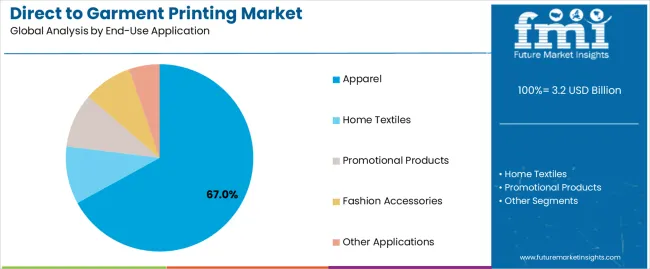
Apparel is projected to represent 67% of the direct to garment printing market in 2025, underscoring its critical role as the primary application for quality-focused businesses seeking superior customization benefits and enhanced design credentials. Commercial users and fashion brands prefer apparel applications for their established demand patterns, proven market acceptance, and ability to maintain exceptional profit profiles while supporting personalized offerings during diverse merchandising experiences. Positioned as essential applications for discerning businesses, apparel offerings provide both revenue excellence and differentiation advantages.
The segment is supported by continuous improvement in garment pretreatment technology and the widespread availability of established distribution infrastructure that enables quality assurance and premium positioning at the retail level. Additionally, printing service providers are optimizing production workflows to support market differentiation and accessible custom pricing. As printing technology continues to advance and consumers seek personalized fashion solutions, apparel applications will continue to drive market growth while supporting brand differentiation and consumer engagement strategies.
The direct to garment printing market is advancing rapidly due to increasing personalization consciousness and growing need for on-demand production choices that emphasize superior customization outcomes across fashion segments and promotional product applications. The market faces challenges, including higher equipment investment costs, pretreatment requirements for optimal results, and maintenance complexities affecting operational efficiency. Innovation in automated systems and specialized ink development continues to influence market development and expansion patterns.
The growing adoption of direct to garment printing in e-commerce platforms and direct-to-consumer business models is enabling businesses to develop merchandising patterns that provide distinctive customization benefits while commanding premium positioning and enhanced personalization characteristics. Online applications provide superior design flexibility while allowing more sophisticated inventory management across various retail categories. Users are increasingly recognizing the competitive advantages of DTG printing positioning for premium product customization and efficiency-conscious operational integration.
Modern DTG printing manufacturers are incorporating advanced automation systems, color management technologies, and quality control protocols to enhance printing capabilities, improve production outcomes, and meet commercial demands for high-volume customization solutions. These systems improve printing effectiveness while enabling new applications, including integrated design platforms and specialized pretreatment programs. Advanced automation integration also allows manufacturers to support premium market positioning and productivity leadership beyond traditional printing operations.
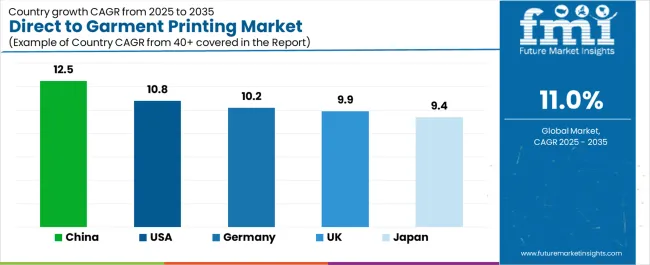
| Country | CAGR (2025-2035) |
|---|---|
| USA | 10.8% |
| Germany | 10.2% |
| UK | 9.9% |
| China | 12.5% |
| Japan | 9.4% |
The direct to garment printing market is experiencing robust growth globally, with China leading at a 12.5% CAGR through 2035, driven by the expanding textile manufacturing sector, growing e-commerce penetration, and increasing adoption of customized apparel products. The USA follows at 10.8%, supported by rising personalization trends, expanding online retail infrastructure, and growing acceptance of on-demand production solutions. Germany shows growth at 10.2%, emphasizing established fashion markets and comprehensive digital printing development. The UK records 9.9%, focusing on premium customized products and creative textile expansion. Japan demonstrates 9.4% growth, prioritizing quality printing solutions and technological advancement.
The report covers an in-depth analysis of 40+ countries, with top-performing countries highlighted below.
Revenue from direct to garment printing consumption and sales in the USA is projected to exhibit exceptional growth with a CAGR of 10.8% through 2035, driven by the country's rapidly expanding e-commerce sector, favorable consumer attitudes toward personalized products, and initiatives promoting customization optimization across major retail regions. The USA's position as a leading fashion market and increasing focus on direct-to-consumer development are creating substantial demand for high-quality DTG printing in both commercial and boutique markets. Major apparel brands and specialty printing service providers are establishing comprehensive production capabilities to serve growing customization demand and emerging personalization opportunities.
Demand for direct to garment printing products in Germany is expanding at a CAGR of 10.2%, supported by rising fashion sophistication, growing textile innovation, and expanding customization infrastructure. The country's developing digital capabilities and increasing commercial investment in quality printing are driving demand for DTG printing across both imported and domestically produced applications. International printing equipment companies and domestic service providers are establishing comprehensive operational networks to address growing market demand for quality DTG printing and personalized textile solutions.
Revenue from direct to garment printing products in the UK is projected to grow at a CAGR of 9.9% through 2035, supported by the country's mature fashion market, established creative culture, and leadership in design standards. Britain's sophisticated retail infrastructure and strong support for customization are creating steady demand for both traditional and innovative DTG printing varieties. Leading apparel brands and specialty printing service providers are establishing comprehensive operational strategies to serve both domestic markets and growing export opportunities.
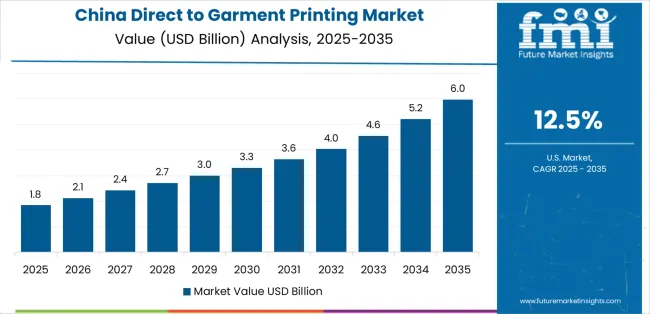
Demand for direct to garment printing products in China is expected to grow at a CAGR of 12.5% through 2035, driven by the country's emphasis on textile expansion, manufacturing leadership, and sophisticated production capabilities for garments requiring specialized customization varieties. Chinese manufacturers and distributors consistently seek commercial-grade technologies that enhance product differentiation and support retail operations for both traditional and innovative fashion applications. The country's position as an Asian manufacturing leader continues to drive innovation in specialty DTG printing applications and commercial production standards.
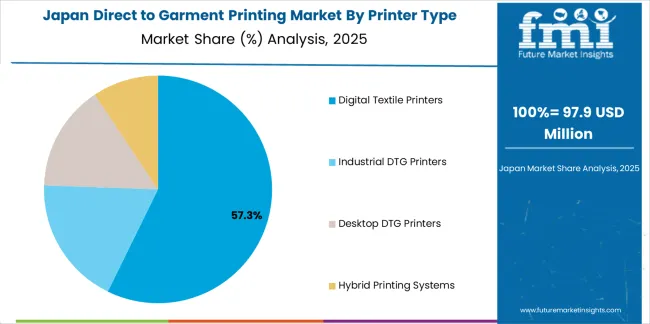
Demand for direct to garment printing products in Japan is projected to expand at a CAGR of 9.4% through 2035, supported by the country's emphasis on quality manufacturing, design standards, and advanced technology integration requiring efficient customization solutions. Japanese businesses and fashion brands prioritize quality performance and precision printing, making DTG printing essential technology for both traditional and modern textile applications. The country's comprehensive manufacturing excellence and advancing fashion patterns support continued market expansion.
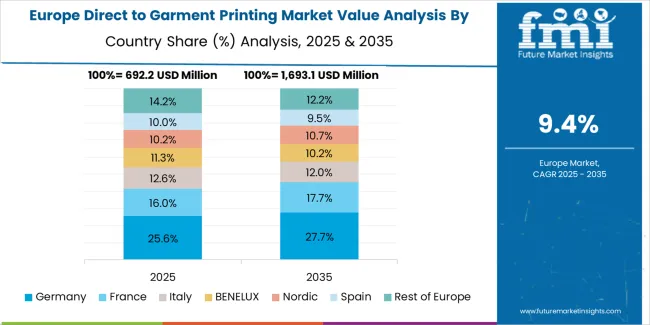
The Europe direct to garment printing market is projected to grow from USD 1.1 billion in 2025 to USD 2.6 billion by 2035, recording a CAGR of 9.0% over the forecast period. Germany leads the region with a 34.0% share in 2025, moderating slightly to 33.5% by 2035, supported by its strong fashion culture and demand for premium, digitally printed textile products. The United Kingdom follows with 26.0% in 2025, easing to 25.5% by 2035, driven by a sophisticated creative market and emphasis on customization and design standards. France accounts for 19.0% in 2025, rising to 19.5% by 2035, reflecting steady adoption of personalized fashion solutions and design consciousness.
Italy holds 10.5% in 2025, expanding to 11.2% by 2035 as fashion innovation and specialty textile applications grow. Spain contributes 6.0% in 2025, growing to 6.5% by 2035, supported by expanding fashion retail and customized apparel handling. The Nordic countries rise from 3.5% in 2025 to 3.8% by 2035 on the back of strong design adoption and advanced digital integration. BENELUX remains at 1.0% share across both 2025 and 2035, reflecting mature, premium-focused markets.
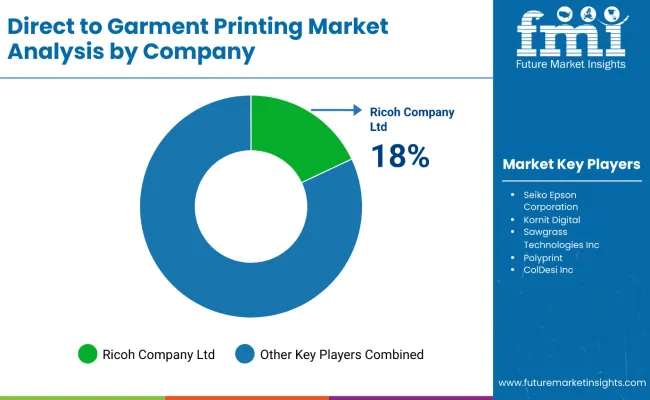
The direct to garment printing market is characterized by competition among established printing equipment manufacturers, specialized DTG technology providers, and integrated printing solution companies. Companies are investing in printhead technologies, advanced ink formulation systems, product innovation capabilities, and comprehensive service networks to deliver consistent, high-quality, and reliable DTG printing systems. Innovation in automation enhancement, color management methods, and application-specific product development is central to strengthening market position and customer satisfaction.
Brother Industries Ltd. leads the market with a strong focus on printing innovation and comprehensive DTG printer solutions, offering commercial printing systems with emphasis on reliability excellence and technological heritage. Epson America Inc. provides specialized printing capabilities with a focus on North American market applications and precision engineering networks. Kornit Digital delivers integrated digital printing solutions with a focus on industrial positioning and operational efficiency. ROQ International specializes in comprehensive textile printing with an emphasis on commercial applications. M&R Companies focuses on comprehensive screen printing and digital solutions with advanced engineering and premium positioning capabilities.
The success of direct to garment printing in meeting commercial customization demands, fashion-driven personalization requirements, and quality assurance integration will not only enhance design outcomes but also strengthen global textile manufacturing capabilities. It will consolidate emerging regions' positions as hubs for efficient digital printing and align advanced economies with commercial customization systems. This calls for a concerted effort by all stakeholders -- governments, industry bodies, service providers, distributors, and investors. Each can be a crucial enabler in preparing the market for its next phase of growth.
How Governments Could Spur Local Production and Adoption?
How Industry Bodies Could Support Market Development?
How Distributors and Fashion Industry Players Could Strengthen the Ecosystem?
How Service Providers Could Navigate the Shift?
| Items | Values |
|---|---|
| Quantitative Units (2025) | USD 3.2 billion |
| Printer Type | Digital Textile Printers, Industrial DTG Printers, Desktop DTG Printers, Hybrid Printing Systems |
| Ink Type | Water-Based Inks, Pigment Inks, Reactive Inks, Discharge Inks |
| Fabric Type | Cotton, Polyester, Cotton-Polyester Blends, Other Fabrics |
| End-Use Application | Apparel, Home Textiles, Promotional Products, Fashion Accessories, Other Applications |
| Regions Covered | North America, Europe, Asia Pacific, Latin America, Middle East & Africa, Other Regions |
| Countries Covered | United States, Germany, United Kingdom, China, Japan, and 40+ countries |
| Key Companies Profiled | Brother Industries Ltd., Epson America Inc., Kornit Digital, ROQ International, M&R Companies, and other leading DTG printing companies |
| Additional Attributes | Dollar sales by printer type, ink type, fabric type, end-use application, and region; regional demand trends, competitive landscape, technological advancements in printhead engineering, automation integration initiatives, quality enhancement programs, and premium product development strategies |
The global direct to garment printing market is estimated to be valued at USD 3.2 billion in 2025.
The market size for the direct to garment printing market is projected to reach USD 9.1 billion by 2035.
The direct to garment printing market is expected to grow at a 11.0% CAGR between 2025 and 2035.
The key product types in direct to garment printing market are digital textile printers, industrial dtg printers, desktop dtg printers and hybrid printing systems.
In terms of end-use application, apparel segment to command 67.0% share in the direct to garment printing market in 2025.






Full Research Suite comprises of:
Market outlook & trends analysis
Interviews & case studies
Strategic recommendations
Vendor profiles & capabilities analysis
5-year forecasts
8 regions and 60+ country-level data splits
Market segment data splits
12 months of continuous data updates
DELIVERED AS:
PDF EXCEL ONLINE
Evaluating Direct to Garment Printing Market Share & Provider Insights
Direct Operated Poppet Valve Market Forecast and Outlook 2025 to 2035
Direct Burial Fiber Optic Cable Market Size and Share Forecast Outlook 2025 to 2035
Directed Energy Weapons Market Size and Share Forecast Outlook 2025 to 2035
Direct Oral Anticoagulants Market Size and Share Forecast Outlook 2025 to 2035
Direct Thermal Linerless Labels Market Size and Share Forecast Outlook 2025 to 2035
Direct Thermal Inks & Coating Market from 2025 to 2035
Directed Energy-Based Surgical Systems Market Growth – Forecast 2025 to 2035
Market Share Distribution Among Direct Thermal Inks & Coating Manufacturers
Market Share Insights of Direct Thermal Linerless Providers
Direct Drive Wind Turbine Market Growth - Trends & Forecast 2025 to 2035
Direct Reduced Iron Market Growth – Trends & Forecast 2024-2034
Directional Drilling Service Market Growth – Trends & Forecast 2024-2034
Direct Methanol Fuel Cell Market Growth – Trends & Forecast 2024-2034
Directional Luminaire Market
Direct-Fed Microbial Products Market
Direct-acting Antiviral Medicines Market
Direct Thermal Printing Film Market Size and Share Forecast Outlook 2025 to 2035
Market Share Insights of Leading Direct Thermal Printing Film Providers
Direct To Chip Liquid Cooling Market Size and Share Forecast Outlook 2025 to 2035

Thank you!
You will receive an email from our Business Development Manager. Please be sure to check your SPAM/JUNK folder too.
Chat With
MaRIA